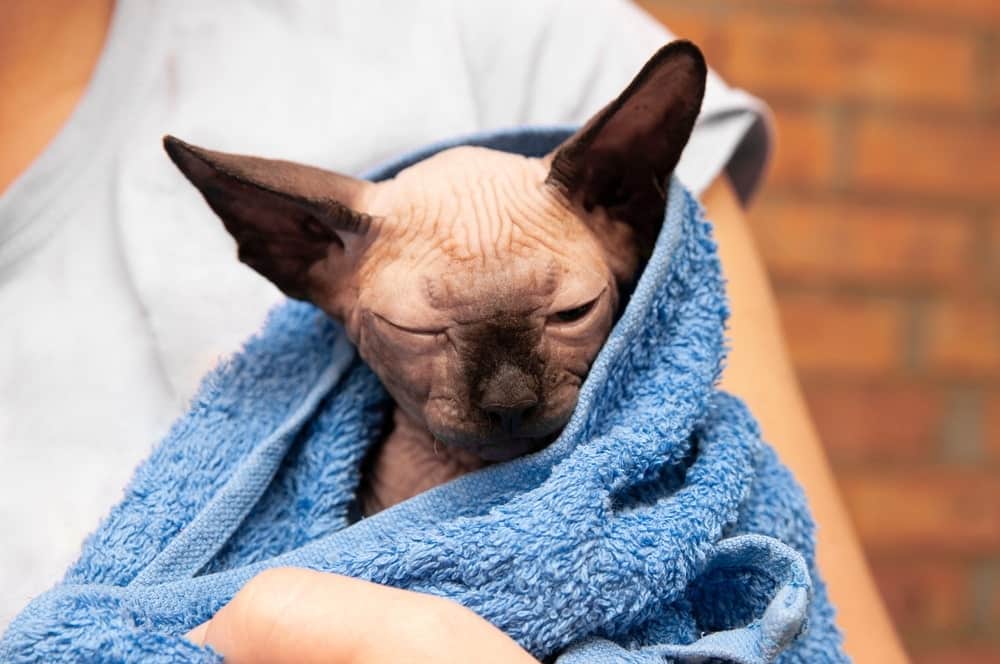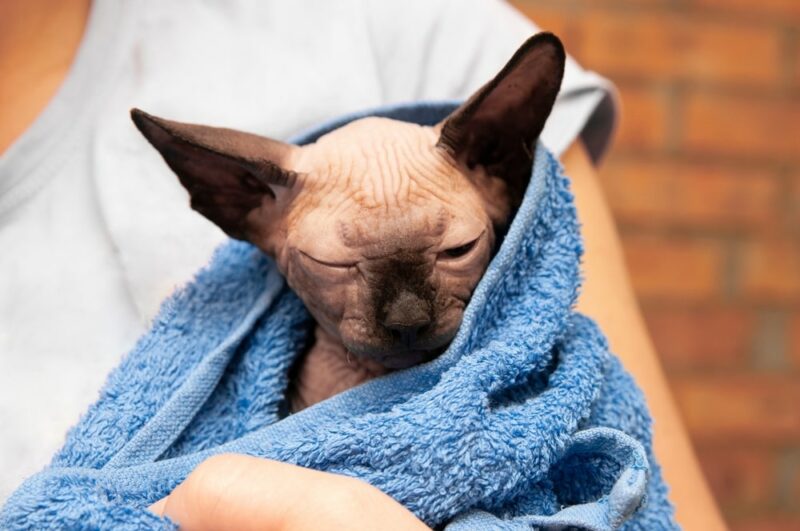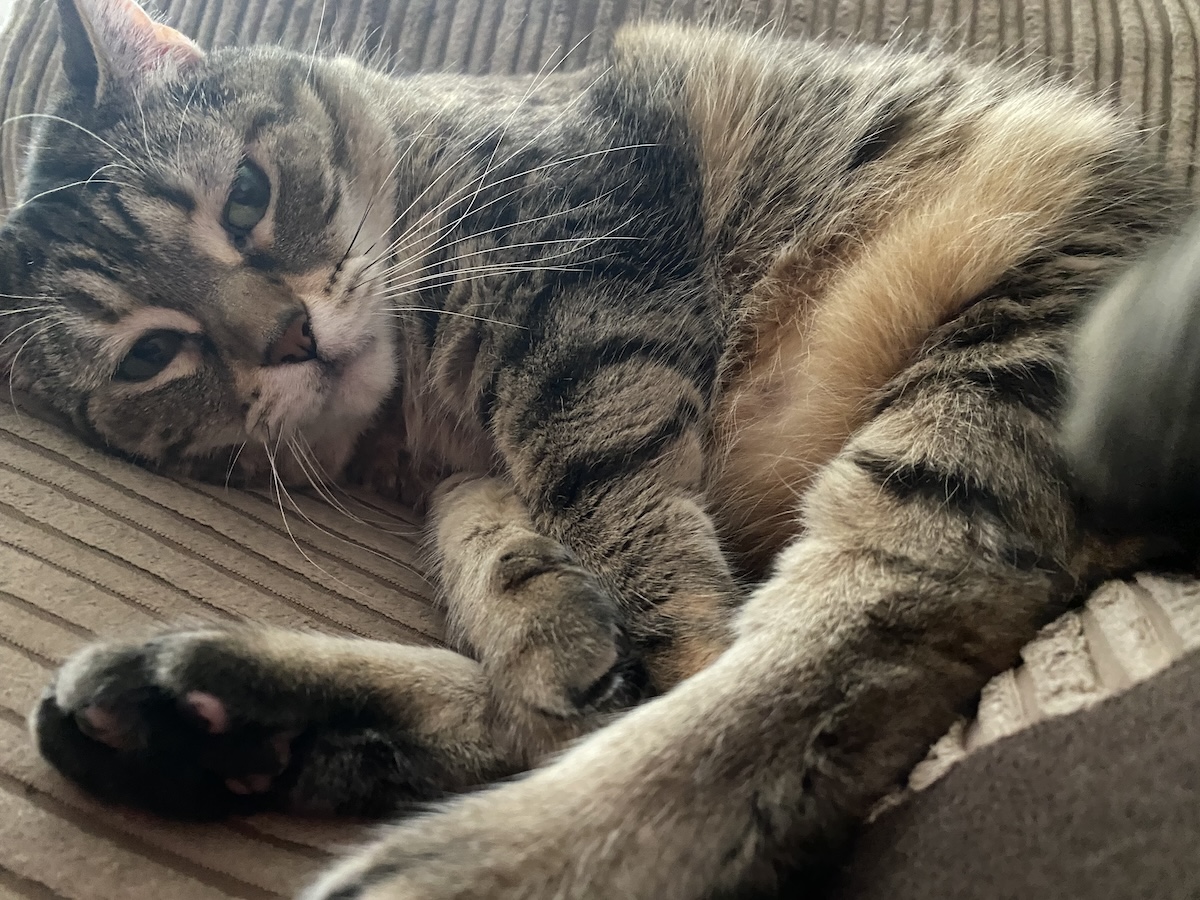It’s easy to assume that a Sphynx cat would require less maintenance than a furry cat, but owners of these hairless cats will know that the opposite is true. Sphynx cats need regular bathing to keep their sensitive and delicate skin healthy and free of bacteria.
The good news is that most Sphynx cats will grow up with regular bathing, so they should—hopefully—come to enjoy being in the water.
In this post, we share eight tips on how to bathe a Sphynx cat.
The 8 Tips to Bathe a Sphynx Cat
1. Gather Your Resources
The last thing you want is to place your cat in the tub only to realize you’ve forgotten something—like the shampoo or towel. This will only cause you and your cat more stress than necessary.
Before you start, prepare by gathering everything you need and placing them within easy reach of the tub.
- A towel for placing on the bottom of the tub
- A towel for drying your Sphynx
- A washcloth
- Hypoallergenic cat shampoo
- Liquid ear cleaner
- Cotton balls
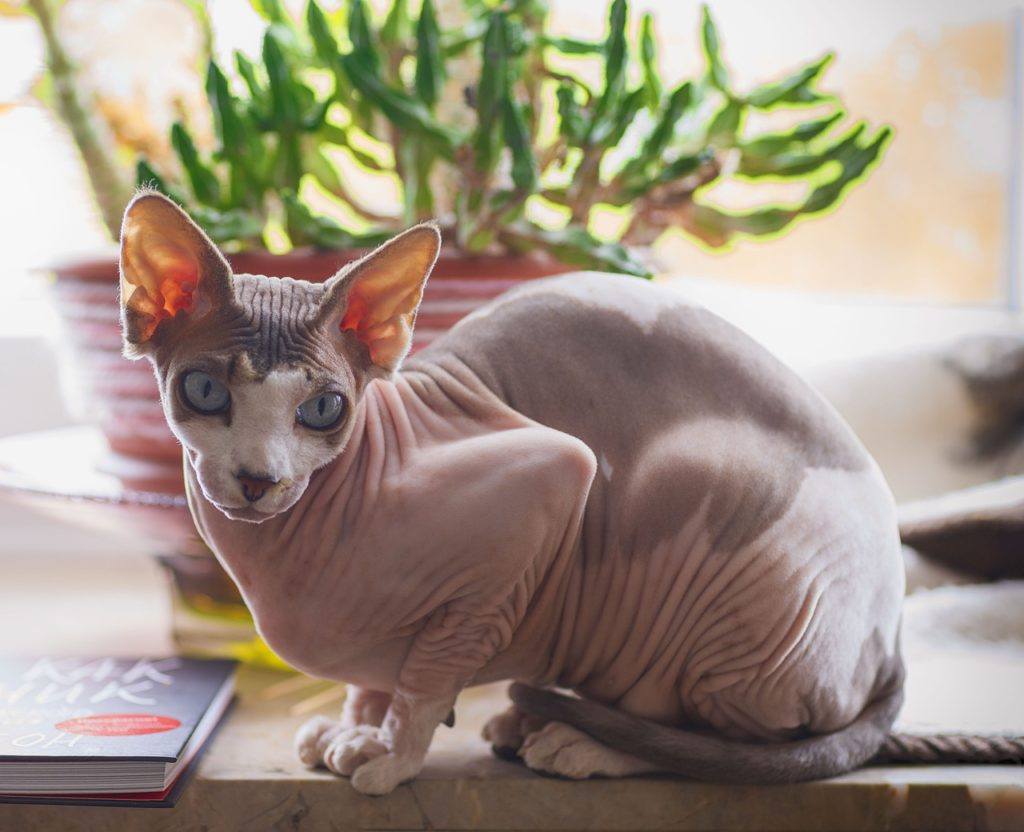
2. Create a Calm Atmosphere
Try to make the room as quiet as possible before you begin. Turn down the TV or radio, and warn everyone else in the house that it’s kitty’s bath time to avoid slamming doors or people coming in and out of the room.
Once the house is quiet, fill the bath with warm water. The sound of the water may startle your cat, so it’s important to do this before bringing them into the same room.
3. Prepare the Bath
Fill the tub or large bowl with enough water to reach your cat’s belly in height, but no more. Make sure the water is nice and warm but not too hot. If your cat is still not used to or doesn’t agree with bath time, you should clip their nails before you attempt to bathe them.
Place one of the towels on the bottom of the tub. This will create a non-slippery surface so that your cat can feel more confident standing in the tub.
Add a small amount of hypoallergenic cat shampoo to the water, and mix it in.
- Only Natural Pet Shampoo - Our vegan, plant-based formulation is made with safe and natural...
- No Soap - A cat and dog wash free from soaps, glutens, dyes, DEA, sulfates and phthalates means it's...
- Colloidal Oatmeal - Formula soothes and nourishes dry, irritated skin, providing itchy skin relief...
There are lots of pet shampoos to choose from, but some are much better than others. We love these two options by Hepper made with all-natural ingredients that gently clean your pet's skin and coat. These pH-balanced formulas contains moisturizing aloe vera and colloidal oatmeal, and it's free of dyes, phthalates, sulfates, and other irritants.
At Catster, we’ve admired Hepper for many years and decided to take a controlling ownership interest so that we could benefit from the outstanding designs of this cool cat company!
4. Bathe Your Sphynx Cat
Gently lower your Sphynx cat into the tub, making sure their back legs go into the water first, then their front legs. Keep your voice calm and low, and talk to your cat to reassure them. Gently hold them in place by keeping one hand over their neck, but do not push them down.
Use the washcloth to wash your cat clean, taking care to clean between the skin folds too. Don’t forget to wash your cat’s tail, but avoid getting water on their face. You can clean between your cat’s toes by gently pressing on their toe pads to expose the claws—dirt often gets trapped here.
Clean your cat’s face using the washcloth, taking care to clean around their eyes too.
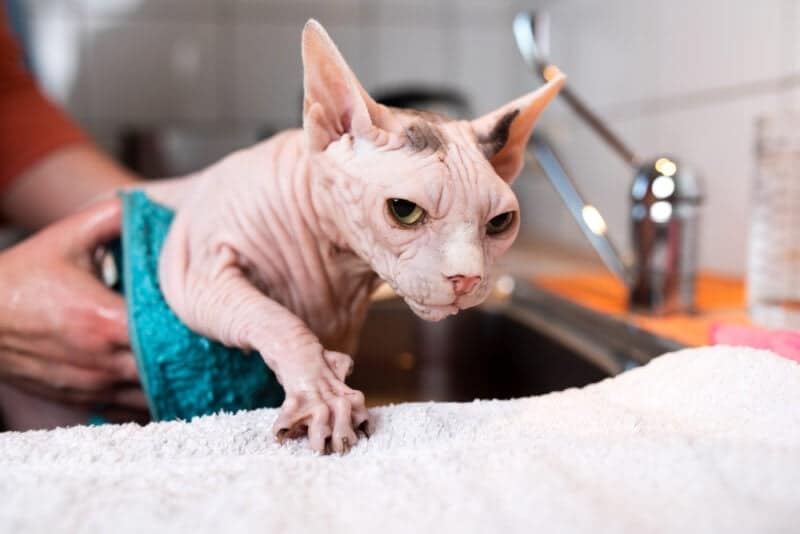
5. Rinse Them Off
When you’re done washing your Sphynx cat, you can either use a jug of clean warm water to rinse them off, taking care not to run the water over their face, or use the shower head. If you’re using a shower to rinse them off, the sound may startle your cat, so make sure you’re holding them in place.
6. Dry Them Off
Wrap your cat up in a big dry towel, and quickly rub them dry. For an even happier cat, use a warm and toasty towel, but make sure it’s not too hot! Your cat may feel as though they want to get away from you by this point, so try not to drag the process out.
That said, don’t let them go just yet—there’s another important step left!
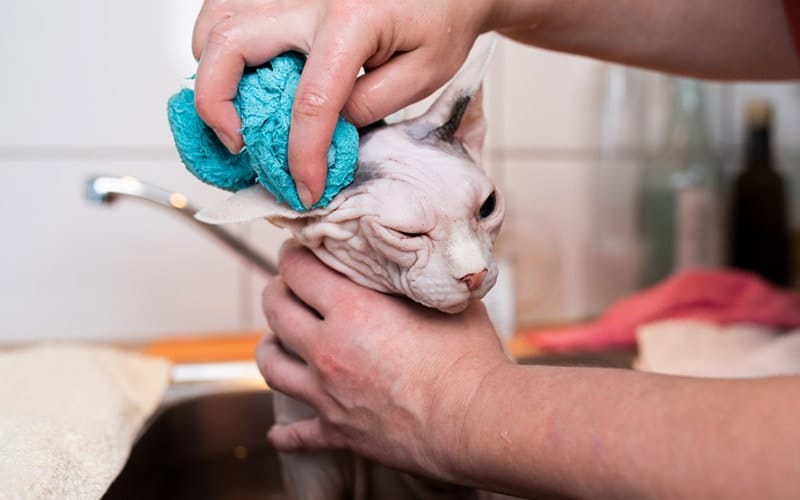
7. Clean the Ears
Sphynx cats need their ears cleaned at least once every 2 to 3 weeks on average, though certain individuals may require more frequent ear cleanings. Using a cat-safe liquid ear cleaner and a cotton ball, gently hold back each ear, and wipe around the outer ear canal. Do not push wax into their ear canal, and do not poke a Q-tip directly into their ear canal either. Not only is this incredibly painful, but it can also disrupt the normal functional mechanism of their ears.
Cleaning your cat's sensitive areas can be tricky, but high-quality wet wipes can make it much easier. Try a natural, hypoallergenic option like Hepper's Wash Wipes, made with moisturizing ingredients and specifically designed to gently clean your cat's skin and fur. These wipes are as convenient as they are effective! At Catster, we’ve admired Hepper for many years and decided to take a controlling ownership interest so that we could benefit from the outstanding designs of this cool cat company!
8. Give Them Treats
As soon as you are done bathing your Sphynx cat, offer them some treats. For a start, your cat will hopefully begin to associate bath times with treats. Most cats don’t tend to love water, so offering your cat a small treat after they’ve been bathed will reassure them that you do still love them!
What Happens If You Don’t Bathe a Sphynx Cat?
All cats naturally produce skin oils from glands located all over their body. These oils form a protective barrier on their skin. In hairless breeds, such as the Sphynx, the lack of hair makes this barrier very obvious, especially when they’re cuddling with humans. Anecdotally, their lack of hair also prompts their skin to produce more of these oils, though this hasn’t been definitively proven by research.
Bathing your cat is recommended as a means to control excessive buildup of this oil. However, this requirement seems to be driven more by human needs rather than your cat’s needs. Not bathing your Sphynx might make things uncomfortable for you, but your cat will likely not be affected as much.
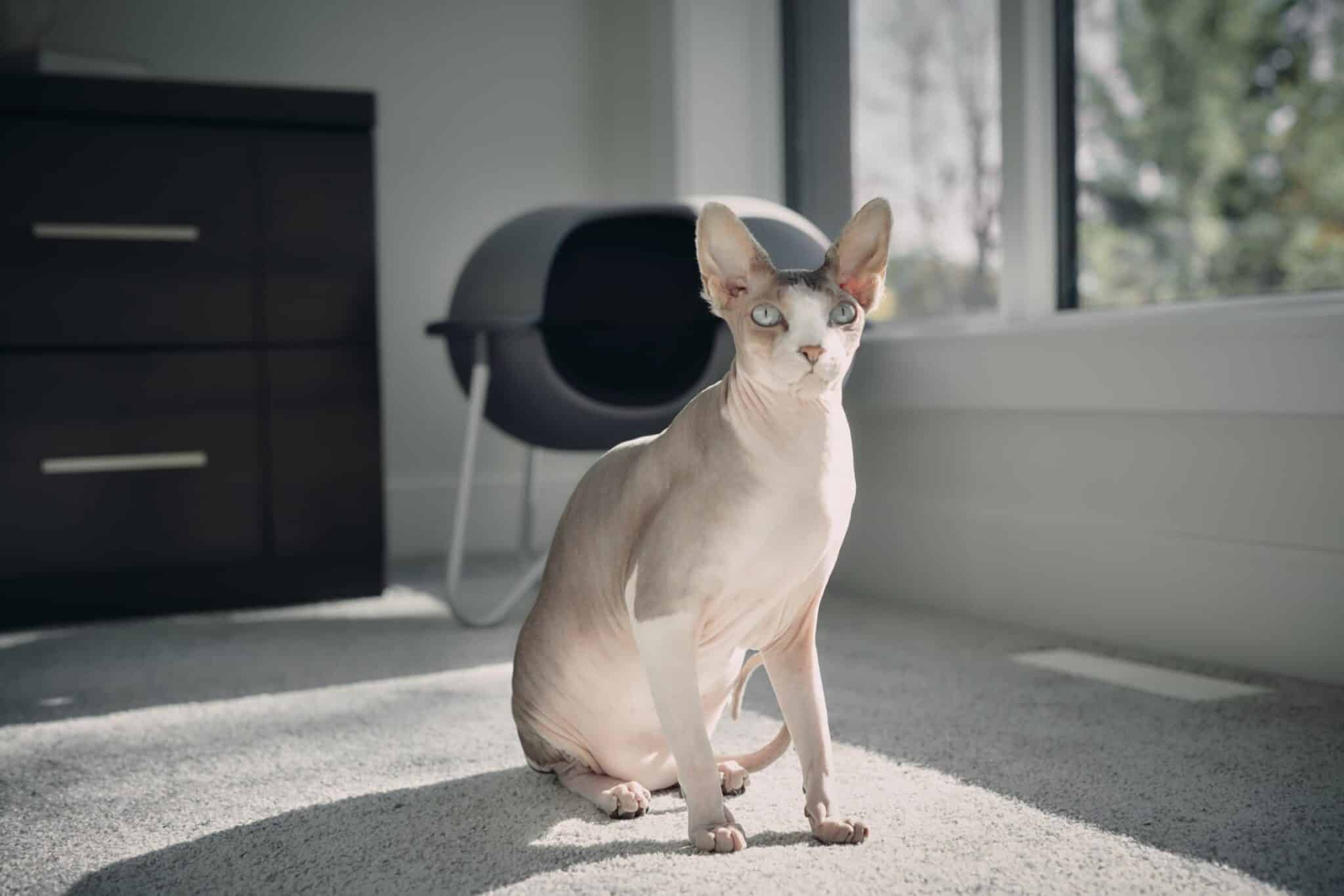
How Often Do You Bathe a Sphynx Cat?
Depending on how active your Sphynx cat is, they’ll need a bath every 3 to 4 weeks, on average. Certain individuals may need more frequent baths. It’s best to have your cat checked by a vet to assess how often you should commit to bathing them. If you notice that your cat smells bad or they take on a rusty or brown appearance, it’s probably time for a bath!
What Should I Bathe My Sphynx Cat With?
Use a shampoo that is specifically for cats. Hypoallergenic shampoos are best, especially those with no scents.
Skin conditions, such as acne and yeast infections, are more common in Sphynx cats. These conditions may require medicated shampoo, so it’s best to speak to a veterinarian about which products are best to use when bathing your Sphynx.
Conclusion
When bathing your Sphynx cat, it’s important to prepare everything you need, then take your time to make the process as stress-free as possible—for both of you! Try not to get water into your Sphynx cat’s ears or onto their face. Instead, use a washcloth to gently clean their face and cotton balls and ear cleaner to clean inside the ears.
With patience, plenty of praise, and a treat to finish off, bathing your Sphynx cat can become an enjoyable and relaxing activity for both of you!
Featured Image Credit: Svitlana Kriukova, Shutterstock
Contents
- The 8 Tips to Bathe a Sphynx Cat
- 1. Gather Your Resources
- 2. Create a Calm Atmosphere
- 3. Prepare the Bath
- 4. Bathe Your Sphynx Cat
- 5. Rinse Them Off
- 6. Dry Them Off
- 7. Clean the Ears
- 8. Give Them Treats
- What Happens If You Don’t Bathe a Sphynx Cat?
- How Often Do You Bathe a Sphynx Cat?
- What Should I Bathe My Sphynx Cat With?
- Conclusion

